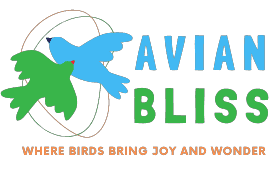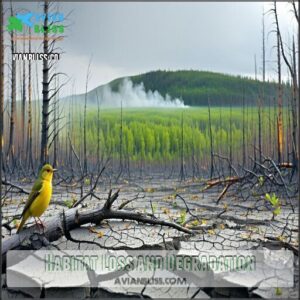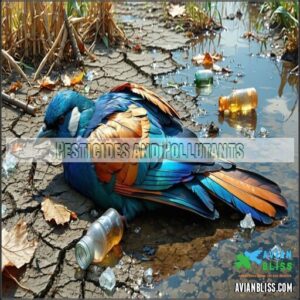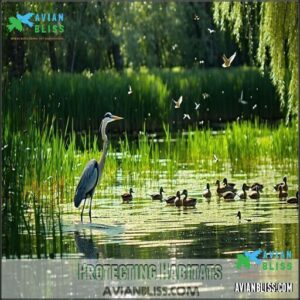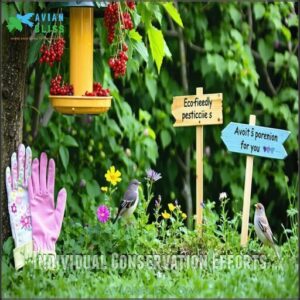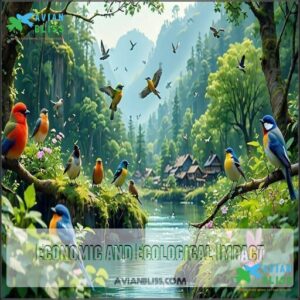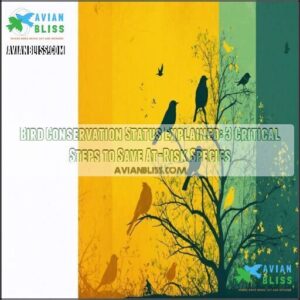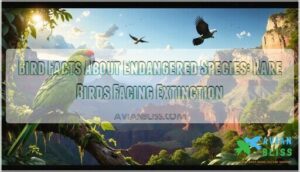This site is supported by our readers. We may earn a commission, at no cost to you, if you purchase through links.

They pollinate plants, spread seeds, and keep pests in check.
Unfortunately, over 500 bird species in the Americas alone are at risk of extinction due to habitat loss, climate change, pollution, and invasive species.
You can help by planting native plants, reducing pesticide use, and supporting conservation efforts.
Citizen science projects, like bird counts, also make a big impact.
Every small action adds up.
Think of it this way: saving birds isn’t just about them—it’s about protecting the balance of nature that we all depend on.
Curious how to start saving birds and preserving the natural world?
Table Of Contents
- Key Takeaways
- Importance of Bird Conservation
- Threats to Bird Populations
- Conservation Strategies
- Individual Conservation Efforts
- Economic and Ecological Impact
- Frequently Asked Questions (FAQs)
- Why is bird conservation so important?
- What is the #1 threat to birds in America?
- How do birds conserve?
- How do birds adapt to urban environments?
- What are unique migration patterns among birds?
- How do birds communicate with each other?
- What are lesser-known predators of bird species?
- How do birds navigate long-distance flights?
- What are the main types of bird diets?
- How do birds navigate during migration?
- Conclusion
Key Takeaways
- You can help birds by planting native plants, reducing pesticides, and joining citizen science projects like bird counts.
- Habitat loss, climate change, pollution, and invasive species are the biggest threats to bird populations.
- Birds play critical roles in ecosystems by pollinating plants, dispersing seeds, and controlling pests.
- Supporting bird conservation efforts protects biodiversity and ensures healthy environments for future generations.
Importance of Bird Conservation
You’ll protect essential ecosystem services when you support bird conservation efforts, as birds maintain environmental health through pollination, pest control, and seed dispersal.
Supporting bird conservation safeguards pollination, pest control, and seed dispersal—essential services that keep ecosystems healthy and thriving.
The survival of over 500 bird species across the Americas depends on your actions to preserve habitats and reduce threats, ensuring these vital environmental indicators continue to benefit both wildlife and humans, which is crucial for maintaining environmental health and supporting bird conservation efforts.
Ecosystem Functions
Birds serve as essential engineers in our ecosystems, performing critical functions that maintain natural balance.
When you spot a flower blooming or a new tree growing, birds likely played a role.
- Pollination services: Birds transfer pollen between plants, ensuring reproduction of many flowering species.
- Seed dispersal: As birds eat fruits and berries, they transport seeds to new areas, helping forests regenerate.
- Pest control: A single bird can consume hundreds of insects daily, naturally reducing agricultural pests.
- Nutrient cycling: Bird droppings return essential nutrients to soil, improving its fertility.
These ecosystem services demonstrate why protecting birds matters—they’re not just beautiful creatures but essential habitat engineers supporting life’s interconnected web.
Cultural Significance
Beyond their ecological role, birds weave through human Cultural Identity across civilizations.
You’ll find Bird Symbolism in ancient cave paintings, Egyptian hieroglyphics, and national emblems where they represent freedom, wisdom, and peace.
Global Folklore features birds prominently—from ravens in Native American stories to cranes in Asian traditions.
Their beauty has provided Art Inspiration throughout history, creating a shared heritage that strengthens public awareness of bird conservation’s ethical obligations.
Economic Value
While birds captivate us culturally, they’re also economic powerhouses. The birding industry generates a remarkable $279 billion annually, creating substantial tourism revenue across communities.
Birding’s economic impact includes:
- Supporting 1.4 million jobs nationwide
- Boosting local businesses through equipment purchases
- Funding critical conservation efforts
- Providing ecosystem services valued at thousands per bird pair
When you spot a warbler in your backyard, you’re witnessing not just natural beauty, but an economic contributor worth protecting. Birds also play a pivotal role in plant diversity and seed dispersal, making them a vital part of our ecosystem.
Scientific Value
While birds fill our wallets through tourism, they’re equally valuable to science.
Avian research has transformed our understanding of evolutionary biology and flight mechanics.
You’ll find scientists studying bird cognition to decipher mysteries of memory and problem-solving.
Their genetic diversity provides vital data for species identification.
As living barometers of ecosystem health, bird ecology signals environmental changes before they affect humans.
This makes avian species indispensable to science—living laboratories that continue to inform multiple scientific disciplines.
Threats to Bird Populations
You’ll find over 500 bird species across the Americas face extinction due to threats like habitat loss, climate change, and toxic pesticides.
These dangers stem primarily from human activities such as deforestation, urbanization, and pollution that continue to fragment critical bird habitats and disrupt natural ecosystems, leading to extinction.
Habitat Loss and Degradation
Across the Americas, habitat loss poses the most severe threat to bird survival.
When forests fall to deforestation and farmlands expand, birds lose critical nesting sites and food sources.
Urbanization creates dangerous fragmentation risks, isolating populations that can’t sustain themselves.
Agricultural expansion converts natural areas birds depend on, while pollution degrades remaining wildlife habitats.
Habitat restoration offers hope, creating corridors that reconnect fragmented landscapes and provide birds the space they need to thrive.
Supporting habitat recovery efforts can greatly aid conservation efforts and help birds recover from the effects of deforestation and pollution.
Climate Change Impacts
Facing rising temperatures, climate change threatens bird populations through key disruptions:
- Habitat shifts force species to relocate as breeding ranges shrink
- Migration disruption alters traditional timing and routes
- Food availability mismatches reduce survival rates when birds arrive too early or late for peak resources
Two-thirds of North American species risk extinction without action. Consider how climate impacts feeders in your backyard.
Environmental conservation efforts that limit warming to 1.5°C could protect 76% of vulnerable bird species, which is a crucial step in addressing the threats they face.
Pesticides and Pollutants
Pesticides and pollution wreak havoc on bird populations.
Toxic chemicals coat seeds, contaminate habitats, and bioaccumulate through prey, weakening immune systems.
Agricultural runoff and pollutants like plastics and heavy metals worsen environmental health risks.
Millions of birds die annually due to unregulated chemicals.
Stricter regulations and mitigation strategies, like organic farming, can reduce pesticide toxicity and pollutant exposure, protecting bird ecosystems.
One approach involves using safer methods for pest control.
| Threats | Effects on Birds | Key Pollutants | Solutions |
|---|---|---|---|
| Pesticide Toxicity | Mortality, immune harm | Neonicotinoids, glyphosate | Organic farming |
| Pollutant Exposure | Habitat contamination | Plastics, heavy metals | Stricter regulations |
| Agricultural Runoff | Food chain disruption | Fertilizers, chemicals | Mitigation strategies |
| Bioaccumulation | Ecosystem imbalance | Toxic prey ingestion | Safer alternatives |
Invasive Species
Invasive species are like uninvited guests wreaking havoc on ecosystems.
They cause habitat loss, compete for food, and prey on endangered birds. Non-native predators, like feral cats, hunt vulnerable species, while starlings outcompete natives for nesting spots.
These disruptions lead to disease spread and ecosystem imbalance, making bird conservation tougher. Control methods, like habitat restoration and monitoring, help reduce these threats.
Here are five impacts of invasive species:
- Predation impacts
- Competition effects
- Habitat alteration
- Disease spread
- Ecosystem imbalance
Conservation Strategies
You can make a real difference for birds by supporting conservation strategies that protect their habitats and reduce threats.
These efforts, like monitoring populations and engaging communities, guarantee healthier ecosystems for both birds and people, and by doing so, support conservation strategies that are crucial for their survival.
Protecting Habitats
Birds can’t thrive without safe spaces.
Habitat protection isn’t just about forests—it includes wetlands, urban areas, and farmlands.
Efforts like land acquisition, habitat restoration, and corridor creation help reverse habitat loss.
Sustainable forestry and wetland conservation also play key roles.
Even planting native species in your backyard supports bird habitats.
Every preserved space becomes a sanctuary for survival.
| Action | Benefit to Birds | Example Efforts |
|---|---|---|
| Land Acquisition | Protects nesting areas | Wildlife reserves |
| Habitat Restoration | Revives degraded lands | Reforestation projects |
| Corridor Creation | Connects fragmented areas | Greenway developments |
Reducing Pesticide Use
Switching to organic farming or using IPM strategies (integrated pest management) can greatly reduce pesticide use, protecting bird populations and ecosystems.
Choosing safe pesticides or trying pesticide alternatives like natural pest predators guarantees healthier environments.
Supporting policy changes to restrict harmful chemicals limits pollution and aids bird conservation.
Every action, big or small, helps improve environmental health and builds effective conservation strategies for the future.
Monitoring Populations
Monitoring bird populations is essential for conservation. It provides insights into population health, habitat changes, and breeding success.
Tracking migration highlights critical pathways to protect. This is crucial for addressing climate impacts and understanding habitat needs.
- Track migration to address climate impacts and habitat needs.
- Monitor breeding success to curb population decline.
- Analyze habitat changes for restoration planning.
- Use bird counts to inform conservation actions effectively.
Public Engagement
Getting others involved inspires impactful change for birds.
Public engagement through community involvement brings people together for conservation.
Join volunteer programs to clean up habitats or restore nesting areas.
Educational outreach sparks interest—school workshops or birdwatching clubs make learning fun.
Citizen science, like bird counts, tracks populations while building awareness.
Smartphones enhance data sharing and make participation more accessible.
| Method | Benefit | Example |
|---|---|---|
| Citizen Science | Tracks populations | Annual bird counts |
| Volunteer Programs | Restores habitats | Local cleanup events |
| Educational Outreach | Inspires awareness and action | School workshops |
Individual Conservation Efforts
You can make a real difference for birds right in your own backyard. Simple actions like planting native plants or reducing plastic use help create safer habitats and healthier ecosystems.
Planting Native Species
Your backyard can become a haven for bird conservation with native plants.
They’re perfect for attracting birds and restoring local ecosystems.
Here’s how to start:
- Choose native plants: Visit local nurseries for seed selection suited to your area.
- Design thoughtfully: Create backyard habitats with food, shelter, and nesting spots.
- Support biodiversity: Native gardens boost bird habitats and protect the environment.
- Maintain regularly: Keep your habitat restoration thriving with care and attention.
Reducing Pollution
Reducing pollution helps protect birds and their habitats.
Small changes can make a big difference:
- Use reusable bags to cut plastic pollution, preventing harm to birds.
- Avoid loud activities near nesting areas to reduce noise pollution.
- Switch to electric tools for better air quality.
- Shield outdoor lights to minimize light pollution, which disrupts birds’ natural behaviors.
Habitat loss and urban development fragments habitats, posing significant challenges to protect birds and their habitats with reusable bags and reduce light pollution.
Supporting Conservation
Supporting bird conservation means taking action that counts.
Advocate for policy advocacy and funding conservation to prioritize habitat restoration. Back private programs or collaborative initiatives that protect bird habitats.
Buying eco-friendly products, like shade-grown coffee, supports sustainable practices. Donations to conservation organizations amplify their impact, helping birds and ecosystems thrive.
Every step, no matter how small, strengthens conservation strategies and proves that individual efforts can safeguard the birds that bring life and balance to our planet.
Citizen Science Projects
Joining citizen science projects like eBird or Project FeederWatch is a hands-on way to support bird conservation.
By participating in bird counts and population monitoring, your birdwatching efforts contribute to key data collection and species identification.
Habitat monitoring guarantees accurate research, guiding conservation impact.
Volunteer training makes these programs accessible for all skill levels.
Every recorded sighting helps scientists understand trends and challenges, turning observations into actionable insights that protect bird habitats and ecosystems worldwide, supporting overall ecosystems.
Economic and Ecological Impact
Birds play a vital role in maintaining healthy ecosystems by pollinating plants, dispersing seeds, and controlling pests.
Birds are nature’s unsung heroes, enriching ecosystems by pollinating plants, spreading seeds, and keeping pests in check.
They also boost local economies through birdwatching, which generates billions of dollars and supports millions of jobs annually, contributing to a significant economic impact through ecosystems.
Birding Industry
Birdwatching isn’t just a hobby—it’s a $279 billion powerhouse supporting conservation and communities.
The birding industry fuels:
- Economic Impact: 1.4 million jobs created worldwide.
- Tourism Revenue: Eco-lodges and guided tours thrive.
- Equipment Sales: Binoculars, cameras, and feeders boom.
- Conservation Funding: Tourism dollars protect habitats.
- Local Economies: Small towns flourish with bird enthusiasts.
Nearly half of all bird species are in decline, but protected areas aid conservation.
Every birdwatcher helps sustain nature while enjoying its beauty—proof that passion can power preservation.
Ecosystem Services
Birds are true ecosystem engineers.
Their pollination services and seed dispersal sustain biodiversity, while pest control protects crops and gardens from harmful insects.
They aid nutrient cycling, enriching soil for healthier plants.
Even their scavenging keeps ecosystems clean and disease-free.
Birds also act as critical ecosystem engineers, providing habitats for other species through nest construction.
| Ecosystem Service | Role in Nature | Benefit to Humans | Example Species | Impact on Balance |
|---|---|---|---|---|
| Pollination Services | Plant reproduction | Food crops | Hummingbirds | Biodiversity boost |
| Seed Dispersal | Forest regeneration | Timber, medicine | Thrushes | Habitat sustainability |
| Pest Control | Reduces harmful insects | Crop protection | Swallows | Agricultural health |
| Nutrient Cycling | Soil enrichment | Fertile farmland | Vultures | Ecosystem resilience |
| Scavenging Services | Waste cleanup | Disease prevention | Crows | Healthier communities |
Human Well-being
Birdwatching isn’t just about spotting feathers—it’s Nature Therapy for your mind.
Spending time with birds can ease stress and anxiety, helping you feel more grounded. Their songs and flight patterns create a Spiritual Connection, lifting your mood and soothing worries.
Studies show bird encounters promote mental health, offering depression relief and emotional balance. Whether you’re admiring a robin or an eagle, birds enhance human wellbeing through simple yet powerful moments in nature.
Ethical Obligations
A bird’s intrinsic rights remind us they’re more than just part of nature—they hold intrinsic value worth preserving.
Bird conservation reflects a moral responsibility to protect life’s diversity and guarantee future generations inherit thriving ecosystems.
Embracing conservation ethics means acting on this ethical obligation to maintain balance and preserve species.
- Restore wetlands to safeguard critical habitats.
- Protect species rights by advocating for habitat preservation.
- Support species preservation efforts to uphold nature’s interconnected systems.
Every action you take honors this shared moral responsibility to preserve thriving ecosystems.
Frequently Asked Questions (FAQs)
Why is bird conservation so important?
A canary in the coal mine, birds signal ecosystem health.
They pollinate plants, disperse seeds, and control pests, keeping nature balanced.
Protecting them safeguards biodiversity, supports agriculture, and guarantees essential ecological services for future generations.
What is the #1 threat to birds in America?
Habitat loss takes the top spot as the biggest threat to birds in America.
Urban sprawl, deforestation, and agriculture destroy nesting sites and food sources, leaving birds struggling to survive in shrinking, fragmented ecosystems, which is a result of habitat loss.
How do birds conserve?
Like nature’s janitors, birds conserve by dispersing seeds, pollinating plants, and controlling pests.
Their actions maintain ecosystems, boost biodiversity, and support agriculture.
By protecting habitats, they guarantee the balance and resilience of our shared environment.
How do birds adapt to urban environments?
In cities, birds adapt by nesting in buildings, foraging in parks, and altering diets to include human food.
They adjust behaviors, like singing at night to avoid noise, showing resilience in bustling urban landscapes.
What are unique migration patterns among birds?
Migration is like a bird’s compass, guiding them across continents.
You’ll find Arctic Terns traveling 22,000 miles annually, while Bar-tailed Godwits fly nonstop for days, showcasing endurance and precision unmatched in nature.
How do birds communicate with each other?
Birds communicate through songs, calls, body language, and even feather displays.
You’ll notice some sing to attract mates, warn of predators, or mark territory, while others use subtle gestures like wing flutters or head bobs to convey their message, making body language a key form of communication.
What are lesser-known predators of bird species?
You mightn’t think of squirrels or bullfrogs as bird predators, but they are.
Squirrels raid nests for eggs, while bullfrogs ambush smaller birds near water.
Even dragonflies prey on hatchlings when given the chance.
How do birds navigate long-distance flights?
You’d be amazed how birds navigate.
They rely on Earth’s magnetic field, the sun’s position, and even stars at night.
Some use landmarks or their exceptional memory, like a GPS built right into their brains.
What are the main types of bird diets?
Birds eat a variety of foods, including seeds, fruits, insects, nectar, fish, and small mammals.
Their diets depend on species and habitat, with some specializing in one type while others adapt to multiple food sources.
How do birds navigate during migration?
You’ll find that birds use the sun, stars, Earth’s magnetic field, and even landmarks to navigate during migration.
Some species also sense polarized light or use their keen memory of familiar routes for guidance.
Conclusion
Think of bird conservation as a thread holding ecosystems together.
Birds pollinate plants, control pests, and spread seeds, keeping nature’s balance intact.
However, habitat loss, pollution, and climate change threaten over 500 species.
By planting native plants, reducing pesticide use, and participating in citizen science, you can make a difference.
Supporting conservation efforts isn’t just about birds—it’s about ensuring a thriving natural world for everyone.
Every small action adds up, and protecting birds means protecting life itself.
- https://www.stateofthebirds.org/2025/
- https://issuu.com/abcbirds/docs/impact_report_2024?fr=xKAE9_zU1NQ
- https://www.birds.cornell.edu/home/center-for-avian-population-studies/
- https://www.humboldt.edu/sites/default/files/wildlife/2025-03/why-birds-matterch3.pdf
- https://www.bird.bot/post/how-do-birds-provide-ecosystems-services
